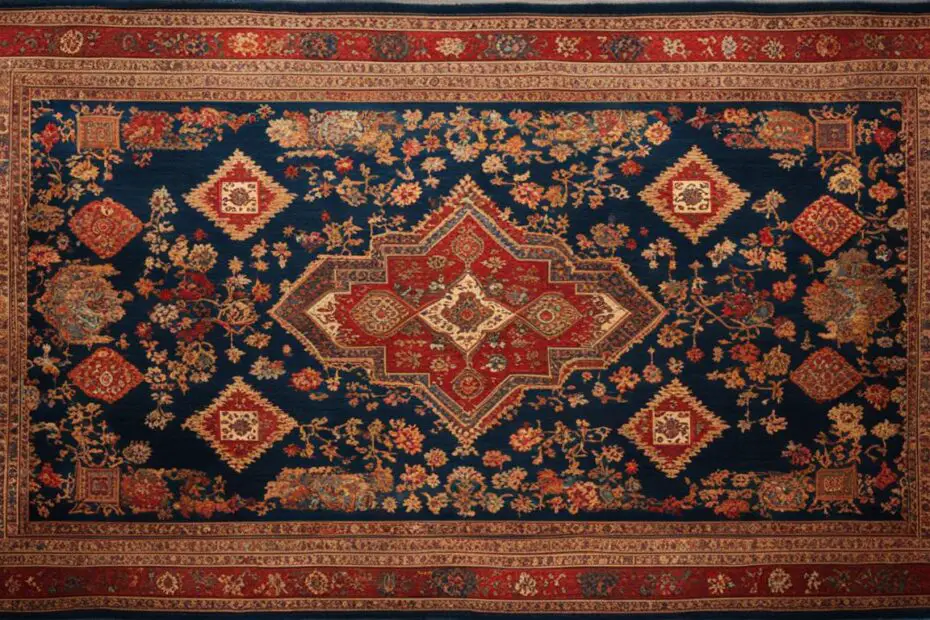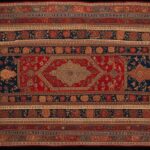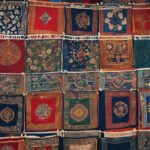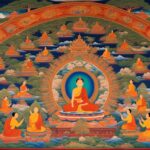Throughout history, prayer rugs have played a significant role in the Islamic faith and cultural traditions. These rugs, often adorned with intricate designs and patterns, provide a designated space for prayer and reflect the artistry and craftsmanship of Islamic cultures. In this detailed guide, we will delve into the origins and evolution of prayer rugs, exploring their historical significance and their place in Islamic worship.
Key Takeaways:
- Prayer rugs have a rich history intertwined with the spread of Islam and Islamic art.
- Islamic carpets, particularly Persian rugs, have greatly influenced the development of prayer rug designs.
- The origins of prayer rugs can be traced back to nomadic tribes.
- Prayer rugs serve as expressive representations of Islamic history and cultural traditions.
- They are highly portable and used for prayer both inside and outside of homes.
Islamic Carpets: The Most Iconic Islamic Art Form and Cultural Tradition
The artistry and craftsmanship of traditional prayer rugs have made them the most iconic form of Islamic art and a significant cultural tradition. These antique prayer rugs hold great historical significance and offer a glimpse into the rich cultural history of Islamic societies.
“Prayer rugs are not only objects of beauty but also symbolic representations of faith and devotion,” says Dr. Ahmed al-Rashid, a renowned expert in Islamic art.
“Their intricate designs and vibrant colors reflect the deep spiritual connection that Muslims have with their faith.”
Islamic carpets, including prayer rugs, have a long history dating back to the early days of Islam. They were highly prized and collected in royal households, with Persian rugs gaining popularity through trade treaties in the 16th century. Prayer rugs, in particular, played a significant role in Islamic societies. They were often used for prayer and were highly portable, allowing Muslims to maintain their devotion regardless of their location.
The designs of traditional prayer rugs vary, showcasing the diversity of Islamic art. From formal and highly detailed patterns to more primitive geometric motifs, prayer rugs are exquisite representations of cultural history. Some rugs even feature intricate tree of life designs, symbolizing the connection between heaven and earth in Islamic belief.
| Design | Features |
|---|---|
| Formal Patterns | Intricate designs with detailed motifs and arabesques |
| Geometric Motifs | Simple yet visually striking patterns inspired by mathematical principles |
| Tree of Life | Symbolic representation of the connection between heaven and earth |
The craftsmanship and artistry of prayer rugs make them highly sought after by collectors and art enthusiasts worldwide. These exquisite carpets not only serve as objects of religious devotion but also showcase the beauty and cultural heritage of Islamic art. Their intricate designs and impeccable craftsmanship continue to captivate and inspire, preserving the rich history and traditions of Islamic societies.
The Beauty of Islamic Carpets: An Enduring Legacy
Islamic carpets, with their vibrant colors, intricate designs, and rich symbolism, have left an enduring legacy in the world of art and culture. These traditional prayer rugs have not only served a functional purpose in Islamic worship but have also become artistic masterpieces that embody the deep spirituality and cultural heritage of Islamic societies.
As Dr. al-Rashid explains, “The beauty of Islamic carpets lies in their ability to transcend time and connect people to a rich historical and cultural tapestry.” The meticulous craftsmanship, attention to detail, and use of high-quality materials have ensured the longevity and preservation of these valuable art forms.
Today, antique prayer rugs continue to be highly sought after by collectors and art enthusiasts who appreciate their beauty and historical significance. They are cherished as valuable works of art that carry with them centuries of tradition, spirituality, and cultural heritage.
The Origins and Evolution of Prayer Rugs
The history of prayer rugs dates back to ancient times when nomadic tribes used animal hides and skins as floor coverings. These early forms of rugs provided practicality and insulation against the cold, harsh ground. However, it was with the introduction of Islam that carpet weaving took on a new level of significance and craftsmanship.
As Islam spread throughout the world, prayer rugs became essential elements for Muslims to perform their daily prayers. The need for a clean and designated space for prayer led to the development of prayer rugs with specific dimensions and designs. These rugs were carefully crafted to be longer than they were wide, with the head of the rug pointed towards Mecca, the holiest city in Islam.
Over time, the designs and motifs of prayer rugs evolved. Initially, prayer rugs featured simple geometric patterns and motifs. However, as Islamic art and culture flourished, prayer rugs began to incorporate more intricate designs, inspired by calligraphy, geometric patterns, and floral elements. These designs not only served a functional purpose but also reflected the spiritual and cultural beliefs of the Islamic community.
| Evolution of Prayer Rugs | Design Features |
|---|---|
| Early Nomadic Period | Animal hides and skins as floor coverings |
| Introduction of Islam | Simple geometric patterns and motifs |
| Islamic Art and Culture | Incorporation of calligraphy, geometric patterns, and floral elements |
Today, prayer rugs continue to be cherished for their historical and cultural significance. They represent not only a tool for worship but also a testament to the rich artistic heritage of Islamic societies. Through their evolution, prayer rugs have become more than just functional objects; they are intricate works of art that narrate the story of Islamic traditions and the devotion of those who use them.
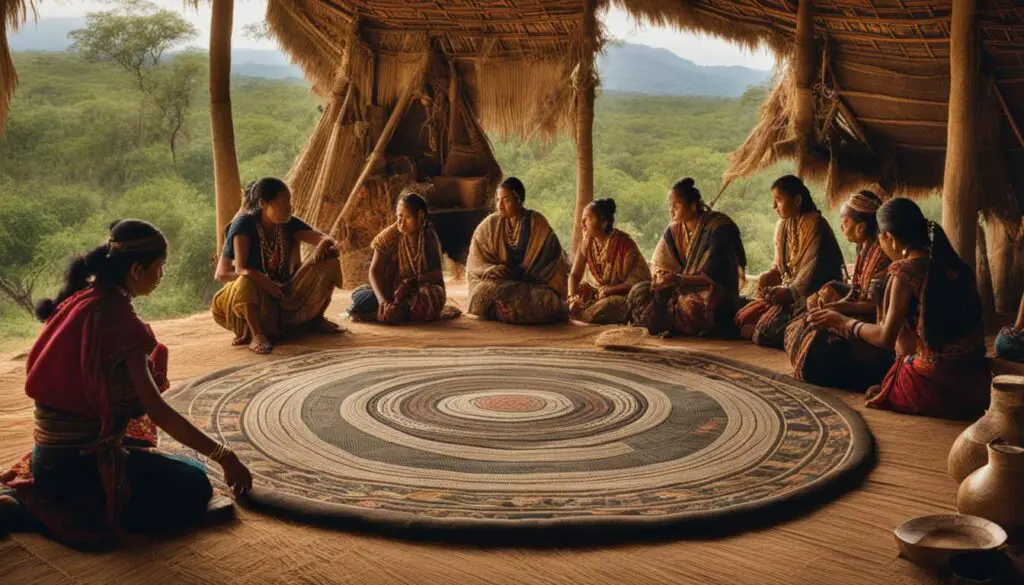
The Significance of Prayer Rugs in Islamic Worship
Prayer rugs hold significant importance in Islamic worship, serving as sacred objects that provide a designated space for prayer and guide the positioning of the body during prayer. These rugs are oriented towards Mecca, the holiest city in Islam, and the worshiper kneels on the back part of the rug, placing their hands and head on the marked areas. It is believed that prayer rugs help create a sense of spiritual connection and focus.
Traditional prayer rugs often feature simple squares or rectangles, allowing for easy alignment with Mecca. Some rugs also incorporate intricate designs such as the tree of life, symbolizing the connection between heaven and earth in Islamic belief. The choice of design can vary based on cultural influences and personal preferences.
Prayer rugs are not limited to indoor use. They are highly portable and can be used for prayer both inside and outside of homes. This flexibility allows Muslims to fulfill their prayer obligations wherever they may be. The portability of prayer rugs also reflects the inclusivity and accessibility of Islam as a religion.
These rugs are considered sacred objects and are treated with great respect. They are not to be stepped on or used inappropriately. Muslims take pride in their prayer rugs and often pass them down through generations, creating a sense of continuity and tradition within families.
The Cultural History of Prayer Rugs
Prayer rugs have a rich cultural history that spans centuries. Islamic civilizations and societies have elevated the art of carpet weaving to a high level of craftsmanship and beauty. The designs and motifs found on prayer rugs often reflect the cultural influences and artistic traditions of the regions where they are produced.
Throughout history, prayer rugs have served as decorative and symbolic representations of Islamic history and cultural heritage. They showcase the skills and artistry of weavers, as well as the cultural diversity within the Islamic world. Each region and culture has its own unique style and techniques for weaving prayer rugs, resulting in a wide array of designs and patterns.
The historical significance of prayer rugs lies not only in their aesthetic beauty but also in their role as objects of status and wealth. The finest prayer rugs were collected in royal households and became highly sought-after treasures. They were often gifted to esteemed individuals and served as diplomatic offerings.
Today, prayer rugs continue to be cherished as important cultural artifacts that represent the rich heritage and traditions of Islamic civilizations. They are appreciated not only for their historical significance but also for their artistic value, making them highly sought after by collectors and enthusiasts around the world.
The Artistry and Craftsmanship of Prayer Rugs
Prayer rugs are not only sacred objects used for Islamic worship, but they are also exquisite pieces of art that showcase the artistry and craftsmanship of Islamic cultures. These rugs are meticulously woven with intricate designs and patterns, reflecting the deep spiritual and cultural significance they hold. The beauty of prayer rugs lies not only in their visual appeal but also in the materials used and the techniques employed in their creation.
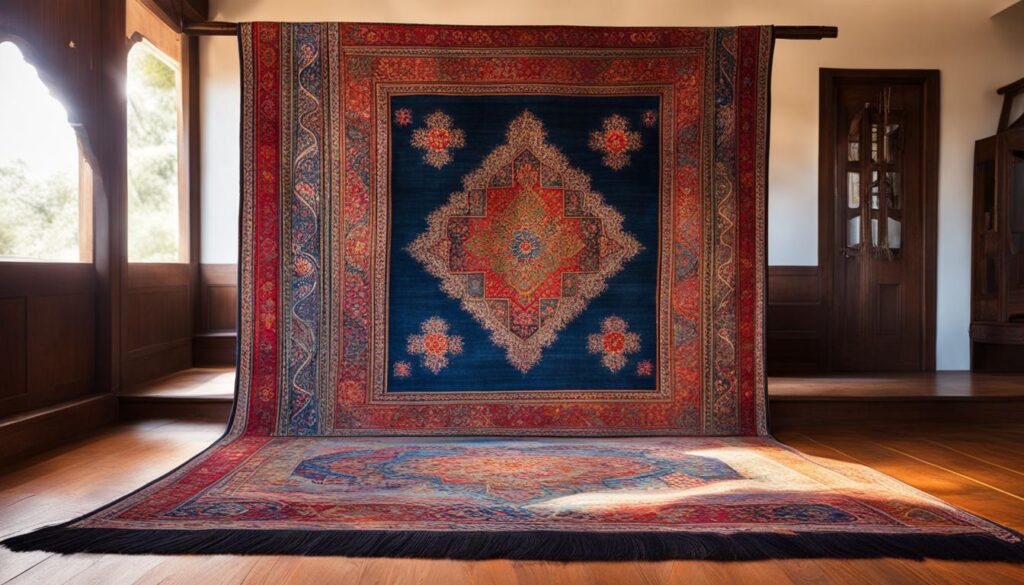
Islamic art and Islamic carpets have a long history of traditional craftsmanship. The materials used to make prayer rugs vary, with wool and silk being the most common. Wool rugs are known for their durability and comfort, while silk rugs exude a luxurious and refined feel. Some prayer rugs feature a combination of both materials, adding texture and depth to the design.
The artistry of prayer rugs is evident in the intricate patterns and designs that adorn them. Geometric motifs, arabesques, and floral elements are commonly seen in prayer rug designs, reflecting the influence of Islamic art. Each region and culture has its own unique style and techniques for weaving prayer rugs, resulting in a diverse range of designs and patterns.
The Beauty of Antique Prayer Rugs
Antique prayer rugs, in particular, possess a unique charm that speaks to their historical significance. These rugs have withstood the test of time, carrying the stories and memories of generations past. They bear the marks of their creators’ skill and dedication, often featuring faded colors and intricate details that exemplify the craftsmanship of a bygone era.
“Prayer rugs are not merely decorative pieces, but tangible expressions of Islamic history and cultural heritage.”
Collectors and art enthusiasts around the world appreciate the beauty and historical value of antique prayer rugs. They are highly sought after for their rarity and the stories they tell. Owning an antique prayer rug is not just owning a piece of art but also preserving a valuable piece of cultural history.
The Significance of Traditional Prayer Rugs
Traditional prayer rugs hold great significance in Islamic worship. They provide a designated space for prayer and guide the positioning of the body during prayer. When a worshiper kneels on a prayer rug, they align themselves towards Mecca, the holiest city in Islam, and place their hands and head on the marked areas of the rug. The design of prayer rugs can vary, with some featuring simple squares or rectangles, while others incorporate intricate tree of life designs.
Islamic art and Islamic carpets have not only influenced the development of prayer rug designs but also shaped the cultural history of prayer rugs. These rugs are not merely decorative pieces, but tangible expressions of Islamic history and cultural heritage. Through their artistry and craftsmanship, prayer rugs continue to be cherished as both sacred objects and stunning works of art.
Conclusion
Prayer rugs have a rich and fascinating history, steeped in the traditions and artistry of Islamic cultures. These rugs hold great significance not only as objects of worship but also as representations of cultural heritage. Throughout the ages, prayer rugs have evolved from simple animal hides used by nomadic tribes to exquisite carpets adorned with intricate designs.
Their historical journey reflects the spread of Islam and the development of Islamic art, with influences from Persian carpet design and other artistic forms such as architecture, calligraphy, and metalwork. The craftsmanship and beauty of prayer rugs have made them highly sought after by collectors and art enthusiasts worldwide, showcasing the depth and diversity of Islamic art.
Today, prayer rugs continue to be used for prayer, providing a designated space and guiding the worshiper during their spiritual practice. However, they are also appreciated as decorative and artistic pieces, adorning homes and exhibitions, and serving as a testament to the cultural history of prayer rugs.
In conclusion, prayer rugs stand as enduring symbols of Islamic heritage, embodying the spiritual devotion and artistic expression of Islamic cultures throughout the ages. Their historical significance and cultural richness make them a valuable part of our shared human legacy, inviting us to appreciate and preserve the beauty of prayer rug history.
FAQ
How did Islamic art influence the development of prayer rug designs?
Islamic art, with its geometric patterns, arabesques, and intricate floral designs, greatly influenced the development of prayer rug designs. The spread of Islam throughout history played a significant role in the evolution of these designs.
What is the significance of prayer rugs in Islamic societies?
Prayer rugs served as portable and decorative representations of Islamic history and cultural traditions. They were used for prayer and held great importance as status symbols and objects of wealth.


